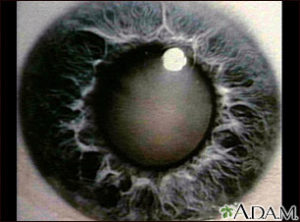Cataract – adult |
||
DefinitionA cataract is a clouding of the lens of the eye. Alternative NamesLens opacity; Age-related cataract CausesThe lens of the eye is normally clear. It acts like the lens on a camera, focusing light as it passes to the back of the eye. Until a person is around age 45, the shape of the lens is able to change. This allows the lens to focus on an object, whether it is close or far away. As a person ages, proteins in the lens begin to break down. As a result, the lens becomes cloudy. What the eye sees may appear blurry. This condition is known as a cataract. Factors that may speed cataract formation are:
In many cases, the cause of cataract is unknown. SymptomsCataracts develop slowly and painlessly. Vision in the affected eye slowly gets worse.
Problems with seeing may include:
Cataracts lead to decreased vision, even in daylight. Most people with cataracts have similar changes in both eyes, though one eye may be worse than the other. Often there are only mild vision changes. Exams and TestsA standard eye exam and slit-lamp examination are used to diagnose cataracts. Other tests are rarely needed, except to rule out other causes of poor vision. TreatmentFor early cataract, the eye doctor may recommend the following:
As vision gets worse, you may need to make changes around the home to avoid falls and injuries. The only treatment for a cataract is surgery to remove it. If a cataract is not making it hard for you to see, surgery is usually not necessary. Cataracts usually do not harm the eye, so you can have surgery when you and your eye doctor decide it is right for you. Surgery is usually recommended when you cannot do normal activities such as driving, reading, or looking at computer or video screens, even with glasses. Some people may have other eye problems, such as diabetic retinopathy, that cannot be treated without first having cataract surgery. Outlook (Prognosis)Vision may not improve to 20/20 after cataract surgery if other eye diseases, such as macular degeneration, are present. The eye doctor (ophthalmologist) can often determine this in advance. Possible ComplicationsEarly diagnosis and treatment are key to preventing permanent vision problems. Although rare, a cataract that goes on to an advanced stage (called a hypermature cataract) can begin to leak into other parts of the eye. This may cause a painful form of glaucoma and inflammation inside the eye. When to Contact a Medical ProfessionalCall for an appointment with your eye care professional if you have:
PreventionThe best prevention involves controlling diseases that increase the risk of a cataract. Avoiding exposure to things that promote cataract formation can also help. For example, if you smoke, now is the time to quit. Also, when outdoors, wear sunglasses to protect your eyes from harmful UV rays. ReferencesAmerican Academy of Ophthalmology Preferred Practice Patterns Cataract and Anterior Segment Panel, Hoskins Center for Quality Eye Care. Cataract/anterior segment summary benchmark – 2016. Updated October 2016. www.aao.org/summary-benchmark-detail/cataract-anterior-segment-summary-benchmark-2016. Accessed October 21, 2016. Tipperman R. Cataracts. In: Gault JA, Vander JF, eds. Ophthalmology Secrets in Color. 4th ed. Philadelphia, PA: Elsevier; 2015:chap 21. Wevill M. Epidemiology, pathophysiology, causes, morphology, and visual effects of cataract. In: Yanoff M, Duker JS, eds. Ophthalmology. 4th ed. Philadelphia, PA: Elsevier Saunders; 2014:chap 5.17. |


